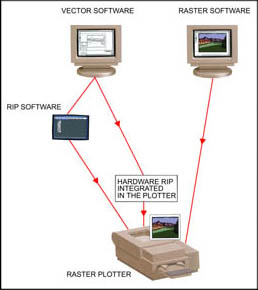|
|
Raster Image Processor
RIP structure and functions
Dynamic mapping can be considered as digital pro-active mapping, which is sufficiently well integrated to be presented via a single interface, or manipulated by a single program. The purpose for exploring spatial data via dynamic mapping is to reveal unknowns and is typically accomplished via a high degree of human interaction; animation is frequently an important component of data exploration. But standalone spatial data exploration is also possible.
The vector image is convert by a Raster Image Processor (software or hardware) to be readable for the printer. While the raster image can be directly read by the printer.
 RIP Processing (Pfiffner 1994)
RIP Processing (Pfiffner 1994)